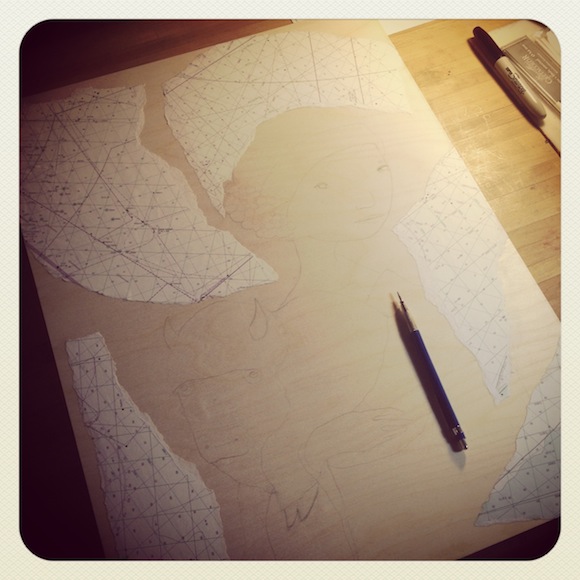One of my goals this year is to share my process even more and give people a better idea of my process and how I put a piece together. Anyone who makes anything is in a constant process of learning and it helps to share with each other how to do things. I did go to art school (yay MassArt!) which I think really helped me focus and immerse myself in making art for four years- I wish I could do that again! But you don't have to go to art school to make art or be an artist. Sometimes I miss the critiques and peer review that art school provides.
In general though, I have always learned a lot just by looking at art and I don't mean a quick glance in a book, online, or in a museum. Those are all great resources but by looking I mean studying a piece I admire- staring it down and taking in all the little nuances that make it what you see before you. I've also learned a lot by experimenting and watching others make things. In the spirit of all that, I give you my first full process post. This is a sort of step by step of my latest painting and how I got from point A to B. I hope you like it!
I usually paint on canvas or wood panels- in this case I used a wood panel. I start with prepping the surface- sanding, laying layers of gesso, and laying down layers of collage. Once the surface is completely dry I draw in the composition with a pencil.
The next part is to start the underpainting. I always do an underpainting - usually with a single color to start and then build layers from there. I use acrylic paint and the way I paint, the layers are really important to build up.
As I work on the underpainting, I block in some color after a while- this is kind of the ugly stage and keeps getting more ugly until the layer build up enough to start looking good again.
Next, I start to focus on some of the details, I don't like to wait too long because I know these will need layers too and if I fear part of the piece- that's the part I want to tackle next. There is always at least one point in creating a new work where I sincerely think it may not work out and each time I push through and fight and discover that it does work out- and the world has not ended. I always learn something as I go through that as well.
At this point I keep adding layers and building the piece up. I go back and forth between detail work and the larger chunks. I try to move around the canvas- working all of it up together as much as I can so that there won't be any piece that stands out as not belonging. If I focus too much on one section and don't step back and work the whole piece- I could be off with colors, drawing, or any element that connects the elements together that make up the whole painting.
Here is a detail of the buffalo closer up. To get the hair to look soft, it was building many layers of various colors up and using a couple of different brushes (some larger) to apply the different sections of paint. For really fine details I use a very small brush- I think it's a 0/3. I also made sure to get the background right before delving into the buffalo- since he's in front and I wanted him to be soft- it was important to get that background looking the way I wanted and then parts of the buffalo- particularly the edges with paint over the background.
Here is the finished piece- it really is a matter of patient layering, letting layers dry, layering more, adding details, looking close and stepping back now and then. Often when I think I'm done or close to done, I'll stop for the night and sleep on it and then look at it the next day. Many times that break away from the painting (and I will do everything to avoid looking at it for several hours) you come back with a little bit of a refreshed eye and can catch things I might have missed or something that still needs some problem solving.
I hope this gives some insight into how I paint. There are many ways to paint- especially with acrylics- the best advice I can give is to play, watch some tutorials or get some books on technique and you'll be surprised how much you learn. Even after many years- I feel like there is always more for me to learn and try.





